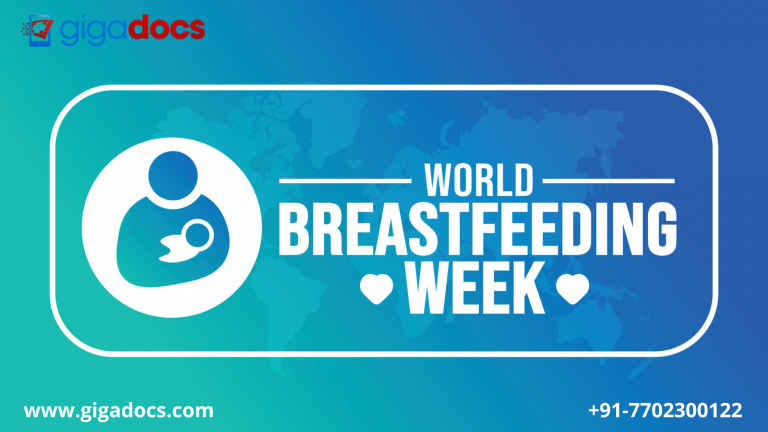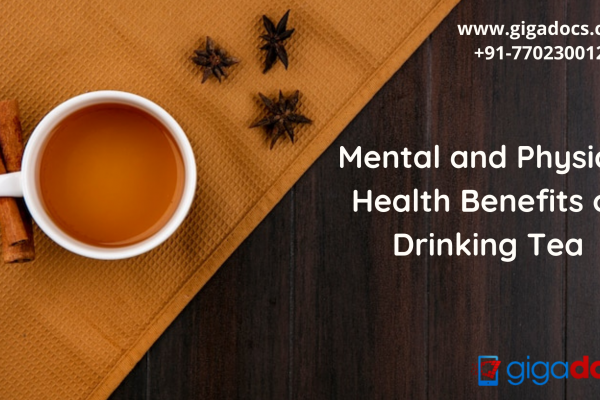Mothers’ milk or breast milk is uniquely tailored to meet a baby’s nutritional needs during the first months of life. Being the best source of nutrition, breastmilk contains antibodies, white blood cells, and essential fatty acids like DHA, which are important for brain and nervous system development.
As we observe World Breastfeeding Week, let’s know more about this wonder milk which reduces the risk of chronic diseases later in life, including obesity, type 2 diabetes, and certain types of cancer. Breastfed babies have a lower risk of SIDS, allergies, asthma, and eczema than formula-fed babies.
In this blog, let’s learn more about World Breastfeeding Week, how it affects a new mother’s health, the rule of three in breastfeeding, and how long should a new mother breastfeed. Gigadocs explains the stages when a mother cannot breastfeed, and we sum up with tips on what a mother should do without breastmilk and how pediatricians and teleconsultation can help.
World Breastfeeding Week and how it affects a New Mother’s health?
World Breastfeeding Week is organized by global health organizations like WABA (World Alliance for Breastfeeding Action), UNICEF, and WHO and aims to promote the importance of breastfeeding for infants. This day focuses on child health, reducing infant mortality, and supporting maternal health. Here is how new mothers benefit from breastfeeding their infants.
- Postpartum Recovery: Breastfeeding can help the uterus contract more quickly after childbirth, reducing postpartum bleeding.
- Cardiovascular Health: Breastfeeding may help improve cardiovascular health by reducing the risk of high blood pressure and cholesterol levels.
- Delayed Return of Menstrual Cycles: Breastfeeding can delay the return of menstrual cycles, offering natural birth control.
- Weight Loss: Breastfeeding burns extra calories, which can contribute to gradual postpartum weight loss.
- Reduced Risk of Certain Diseases: The longer a woman breastfeeds over her lifetime, the greater the potential protective effect against type 2 diabetes, breast cancer, and ovarian cancer.
- Bone Health: Women who breastfeed may have a reduced risk of osteoporosis because their body is accustomed to calcium absorption during lactation.
- Reduced Risk of Postpartum Depression due to releasing oxytocin and prolactin hormones that reduce stress.
What is the “Rule of Three” in Breastfeeding?
The “Rule of Three” in breastfeeding is a general guideline pediatricians share with new breastfeeding parents to help them understand if their baby is receiving sufficient milk during their breastfeeding sessions.
The Rule of Three includes:
- Feeding at least every three hours: Newborns need to feed frequently, about every two to three hours, as their stomachs are small and breast milk is easily digested. This frequent feeding helps ensure the baby gets the necessary nutrients and hydration.
- Feeding for at least three minutes on each breast: During breastfeeding, babies go through different phases of milk flow, with the richer hindmilk coming later in a feeding session. The ‘Rule of Three’ guideline suggests allowing the baby to nurse for at least three minutes on each breast to ensure they receive a balance of foremilk (initial, thirst-quenching milk) and hindmilk (higher-fat, calorie-rich milk).
- Content after feeding for at least three hours: After a satisfying feeding session, a well-fed baby should appear content and satisfied for about three hours before showing signs of hunger again. This contentment can include relaxation, falling asleep, or a general sense of calm.
However, it is important to note that the Rule of Three is not a strict rule. Every baby is different, and their feeding patterns can vary based on age, growth spurts, individual needs, and other factors.
When should a Mother Avoid Breastfeeding?
In certain situations or conditions, breastfeeding may be contraindicated or require careful consideration. New mothers can consult with a lactation consultant on the Gigadocs app to discuss their specific circumstances and receive personalized guidance. Here are some common situations in which breastfeeding may need to be approached with caution:
- Mental Illness or Medications: Mental illnesses, medical conditions, and certain medications may pose a risk to the baby through breast milk.
- Certain Infections: Infections such as active tuberculosis, HIV, and untreated brucellosis can risk transmission to the baby through breast milk.
- Galactosemia: Galactosemia is a rare genetic disorder affecting a baby’s ability to metabolize galactose, a sugar in breast milk.
- Substance Use: If a mother uses certain substances, such as illicit drugs or excessive alcohol, breastfeeding may not be recommended due to potential harm to the baby.
- Radioactive Iodine Treatment: If a mother is undergoing radioactive iodine treatment for certain thyroid conditions, breastfeeding may need to be temporarily interrupted.
- Breast Surgery or Anatomical Issues: Some breast surgeries or anatomical issues (e.g., breast reduction) may impact milk production or the baby’s ability to latch effectively.
- Infant Allergies or Sensitivities: In rare cases, healthcare providers may recommend specialized formulas if an infant has severe allergies or sensitivities to proteins in breast milk.
- Maternal Herpes Simplex Virus (HSV) Lesions: If a mother has active herpes lesions on the breast, breastfeeding from the affected breast may need to be temporarily avoided to prevent virus transmission.
- Chemotherapy or Radiation Therapy: If a mother is undergoing certain cancer treatments, breastfeeding may need to be temporarily interrupted to protect the baby from exposure to chemotherapy drugs or radiation.
How does Breastfeeding affect an Infant’s health?
Breastfeeding is a natural way to nourish infants and support their overall health. Here is how breastfeeding affects an infant’s health:
- Breast milk contains antibodies, white blood cells, and other immune-boosting components that help protect infants from infections, illnesses, and diseases.
- Breast milk is easy to digest, reducing the likelihood of digestive problems such as constipation and diarrhea.
- Breastfeeding may reduce the risk of chronic diseases later in life, including obesity, type 2 diabetes, and certain types of cancer.
- Breastfed babies tend to gain weight at a healthier pace, reducing the risk of obesity when they group up.
- Breast milk contains prebiotics that support beneficial gut bacteria growth, promoting a healthy gut microbiome and reducing the risk of gastrointestinal issues.
Should infants be fed formula-based milk? We discuss in the next section-
What should new mothers do in the Absence of Breast Milk?
In cases where a new mother cannot breastfeed, formula feeding can provide a suitable alternative to ensure her baby receives proper nutrition and care. Formula milk is designed to mimic the nutritional composition of breast milk as closely as possible. Here are some tips for new mothers in the absence of breast milk:
- Consulting a pediatrician can help new mothers with appropriate formula options, feeding schedules, and any specific considerations for their baby’s health.
- Newborns feed every 2-3 hours, but individual feeding patterns vary. New mothers must observe their baby’s cues and establish a feeding routine.
- New mothers must burp their babies during and after feedings to help prevent gas and discomfort.
Each baby is different; the most important thing is ensuring they are well-nourished, loved, and cared for.
If you have specific concerns or questions about formula feeding, don’t hesitate to consult Gigadocs to connect with a pediatrician for guidance.
Download the Gigadocs app from-
- IOS App – apple.co/2W2iG4V
- Android App – bit.ly/33AQoRC
To know more e-mail, at info@gigadocs.com




